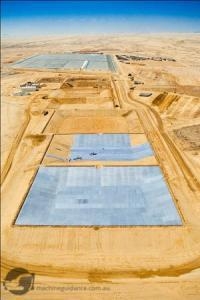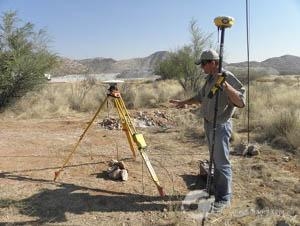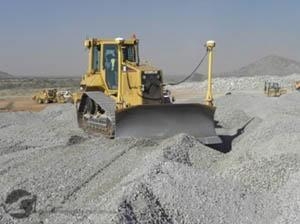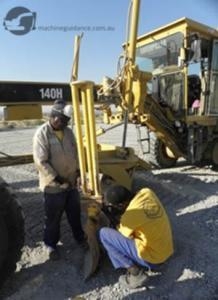Minimising Mine Costs With Machine Guidance
Utilising machine guidance on a Uranium Mine project to minimise costs and increase yields including a reduction in surveying time by approximately 95 percent.Published: September 2014
Author: Trimble Heavy Civil Construction Division

1
Namibia's geographic location in southwestern Africa makes it home to one of the most diverse, challenging, and arduous environments on the planet. The country has a uranium-rich land that can be rugged and highly corrosive.
Trekkopje Mine is the site of a large, shallow uranium resource hosted in calcium carbonate; the mine is located in arid desert region of western Namibia. In 2007, Trekkopje Projects was hired to work on the new uranium extract project in this area. Trekkopje Projects is an earthworks and construction company with a broad range of experience, from building heap leach pads, berms and ponds, to smaller-scale road building projects. The company also offers crushing services, as well as heavy equipment transport, within the 40 to 60-ton range.
The heap-leaching process is used to extract the mineral from calcium carbonate deposits. During the leaching process liquid - often sulphuric acid - is introduced on the top of the pile and percolates down until it reaches a liner below the pile, where it is caught and pumped to a processing plant. Lance Enslin, operations manager for Trekkopje Projects, explains that in order for the heap-leaching process to be effective, it requires extensive and precisely level surfaces (or pads) for the mine tailings.
"The pad surface has to be exactly as specified per design, with a consistent two percent drop; in this case it had a tolerance of only five to 10 millimeters," said Enslin. "What was most critical however, was maintaining the levels as per design as the pad was built."
The pads in question covered a staggering area of approximately 280,000 square meters. Because this section required highly-accurate levelling throughout, Enslin and his team approached this process in a diligent and thoughtful manner. The manual, 'dip-stick' method of surveying was adopted first. The 'dip-stick' method describes a process of using a rod or stick with a pre-determined mark, ascertained by the site Supervisor or Quantity Surveyor, to indicate the required height of a surface. A crew member uses the dip stick to measure the height of the surface at predetermined intervals. Essentially, a piece of gut-line was secured and held taut between the two fixed points. This assures that at any point along that piece of line, the height of the gut-line will be constant.

2
After levelling the first pad using the traditional survey method, Enslin realized that this process was not only time intensive, but also error prone. The process was further exacerbated when a surveyor had to be called out again to the site to correct any anomalies. This waiting in turn impacted all project costs; machines would stand idle, crew members had to stop and start work, fuel was wasted, etc. On the first attempt, using the 'dip-stick' method to build the mini-pad took the surveyor 14 days to just place the pegs.
Imposed specification tolerances by AMEC, a consulting company working in the energy, minerals, metals, environment, and infrastructure industries, also helped to solidify the argument for moving beyond traditional survey methods. AMEC imposed specifications on the project so tight that room for error or compromise was not a consideration.
"Because of our geographical position and the shortage of surveyors in the region, it became difficult to secure a surveyor to come and do the grade checks for us, to ensure that our machines were in fact cutting the correct levels," said Enslin. "So while we waited for him to arrive on site, we had machines and workers standing idle, unable to continue."

3
Facing these challenges, Trekkopje Projects started to investigate other levelling methods. Enslin and his team wanted to explore the most cost-effective option. They began by making contact with Cat Namibia, their heavy equipment dealer. Cat Namibia put the group into touch with CLM Positioning Solutions, Trimble's distributor for Southern Africa.
After consulting with CLM, Trekkopje Projects selected the Trimble GCS900 3D Grade Control System as well as the Trimble Site Positioning System with the SCS900 Site Controller Software. Trekkopje Projects also purchased a GNSS Base Station designed for single site GNSS reference station setup.
The GCS900 system is a cutting-edge earthmoving grade control system that puts design surfaces, grades and alignments inside the cab, checked by the operator on an easy-to-read on-board monitor screen providing rapid access display.
Trekkopje Projects loaded and used the machine control system on two dozers and a moto grader. The Trimble system operates via satellite, an initial fixed base point of reference on the ground must be established. All the resulting positions of machines and rovers are based on this location. A correction signal from the base is used by the receivers on the machines to provide the real time elevation of the pad that is being constructed. This elevation is displayed on the control box inside the cab. From inside the cab, the machine operator can easily see where he needs to grade the material to accurately fit the design.

4
Once the height requirement has been loaded onto the Trimble GCS900 system, only material that must be removed will be taken away, leaving material that already complies with the specification untouched. With the results showing inside the cab, the operator can use the grader to precisely scrape away the excess and leave the correctly graded level of material intact.
The machines use the signal from the base station to guide them, not only in horizontal position but in elevation as well. The areas are so large, the supervisor needs a method to check what the machines are doing and what volume of material is being laid - tasks he performs using the SCS900 software. The software works exactly like the machine by comparing the actual position against a surface model at all times, not just individual points.
"I thought there was no way that I could learn how to use this computer-driven measuring system so quickly, but within a very short time I had mastered the basics of the Site Positioning System, and with CLM's on-going, constant support, a mere phone call away, I was up and running competently within days," said Enslin. "What makes it so easy is that it is icon-driven."
The system is well suited to the non-surveyor. The Trimble SCS900 Site Controller Software was designed from the ground up for contractors carrying out measurement and stakeout for earthworks, highways, landfill cells, and mining.

5
"The machine control was fitted on the grader," Enslin. "While the dozers and dam scrapers worked on bulk earthworks, moving the material to a rough configuration, and what we referred to as the 'Trimble grader', the one with the machine control in place, followed behind doing the precise cutting."
With the new system in place, surveying time on the project was reduced by a dramatic 95 percent. The result is faster job cycles, with time used more productively and less time wasted waiting for surveying and grade checking.
"Even our operators, who were initially sceptical about using 'a robot' as they called it, are now more than happy to use it as they can see how easy and accurate it makes their workload," said Enslin. To prove the point, our "final levels" operator who's in his 60s and a stalwart of the "old ways" eventually agreed to try the "robot". We had him comfortably using it in under 15 minutes.
6
With the site plan and grade information displayed in the cab, operators can finish jobs faster and thus uptime and productivity is dramatically improved. And, although a surveyor or engineer is still required to verify measurements, there is very little or no rework required.
According to Enslin the Italian Site Engineer, under contract from AMEC UK, was impressed with the accuracy and results of the machine control system. In fact, the site engineer said that the build was the best he had seen in Africa, in terms of the quality and accuracy achieved on the project.
Enslin is enthusiastic about the system's capabilities in particular because it gave him and his crew the ability to remain productive and continue to move forward on the project-and to do so with accuracy and confidence- instead of waiting for the availability of surveyors.
Credit Source
Trimble applies technology to make field and mobile workers in businesses and government significantly more productive. Solutions are focused on applications requiring position or location-including surveying, construction, agriculture, fleet and asset management, public safety and mapping. Read more about Trimble Heavy Civil Construction at www.trimble-productivity.com.
Return to Articles

